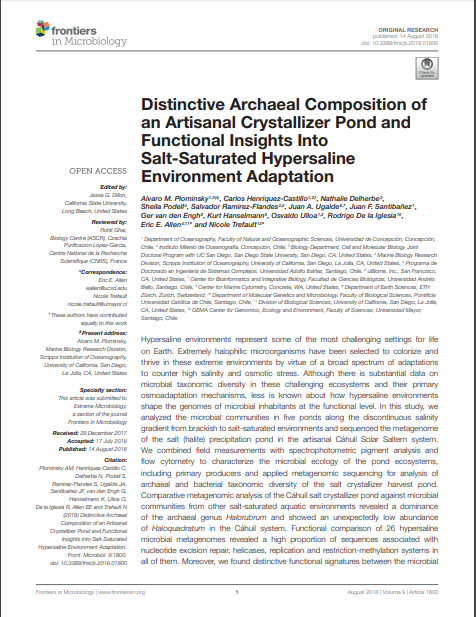Distinctive Archaeal Composition of an Artisanal Crystallizer Pond and Functional Insights Into Salt-Saturated Hypersaline Environment Adaptation

Fecha
2018Autor
Trefault, Nicole [Univ Mayor, GEMA Ctr Genom Ecol & Environm, Santiago, Chile]
Plominsky, Alvaro M.
Henriquez-Castillo, Carlos
Delherbe, Nathalie
Podell, Sheila
Ramírez-Flandes, Salvador
Ugalde, Juan A.
Santibañez, Juan F.
van den Engh, Ger
Hanselmann, Kurt
Ulloa, Osvaldo
De la Iglesia, Rodrigo
Allen, Eric E.
Ubicación geográfica
Notas
HERRAMIENTAS
Acceda a títulos restringidos
¿Cómo descargar?Resumen
Hypersaline environments represent some of the most challenging settings for life on Earth. Extremely halophilic microorganisms have been selected to colonize and thrive in these extreme environments by virtue of a broad spectrum of adaptations to counter high salinity and osmotic stress. Although there is substantial data on microbial taxonomic diversity in these challenging ecosystems and their primary osmoadaptation mechanisms, less is known about how hypersaline environments shape the genomes of microbial inhabitants at the functional level. In this study, we analyzed the microbial communities in five ponds along the discontinuous salinity gradient from brackish to salt-saturated environments and sequenced the metagenome of the salt (halite) precipitation pond in the artisanal Cahuil Solar Saltern system. We combined field measurements with spectrophotometric pigment analysis and flow cytometry to characterize the microbial ecology of the pond ecosystems, including primary producers and applied metagenomic sequencing for analysis of archaeal and bacterial taxonomic diversity of the salt crystallizer harvest pond. Comparative metagenomic analysis of the Cahuil salt crystallizer pond against microbial communities from other salt-saturated aquatic environments revealed a dominance of the archaeal genus Halorubrum and showed an unexpectedly low abundance of Haloquadratum in the Cahuil system. Functional comparison of 26 hypersaline microbial metagenomes revealed a high proportion of sequences associated with nucleotide excision repair, helicases, replication and restriction-methylation systems in all of them. Moreover, we found distinctive functional signatures between the microbial communities from salt-saturated (>30% [w/v] total salinity) compared to sub-saturated hypersaline environments mainly due to a higher representation of sequences related to replication, recombination and DNA repair in the former. The current study expands our understanding of the diversity and distribution of halophilic microbial populations inhabiting salt-saturated habitats and the functional attributes that sustain them.
URI
https://doi.org/10.3389/fmicb.2018.01800http://repositorio.umayor.cl/xmlui/handle/sibum/6150
https://www.frontiersin.org/articles/10.3389/fmicb.2018.01800/full
Coleccion/es a la/s que pertenece:
Si usted es autor(a) de este documento y NO desea que su publicación tenga acceso público en este repositorio, por favor complete el formulario aquí.